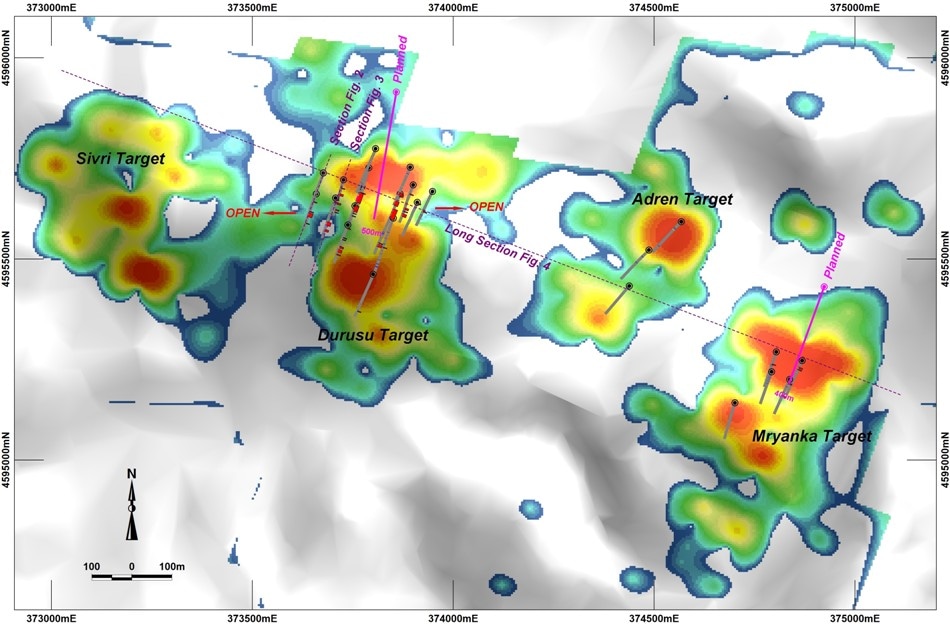Dec 13 2019
Velocity Minerals Ltd., a gold exploration and development company, has announced that drill results for the Adren, Mryanka, and Durusu targets located at the Obichnik Gold Project, Bulgaria, have been received.
 Map of the Obnichnik Gold Project, showing the targets and drill traces at Durusu, Mryanka, Sivri, and Adren. The drill hole locations are displayed on a gridded image of Velocity’s gold in soil anomalies. Image Credit: Velocity Minerals Ltd.
Map of the Obnichnik Gold Project, showing the targets and drill traces at Durusu, Mryanka, Sivri, and Adren. The drill hole locations are displayed on a gridded image of Velocity’s gold in soil anomalies. Image Credit: Velocity Minerals Ltd.
The Obichnik Gold Project is identified as an intrusion-related base metal and gold mineralizing system comprising near-surface high-grade sub-epithermal gold targets as well as deeper bulk tonnage porphyry gold potential, collectively hosted inside a large surface alteration zone of 2.5 km x 1.5 km.
Preliminary drilling performed at the Durusu target returned 43.4 m @ 3.89 g/t gold from the ODD-001 drill hole. At the same Durusu target, current step-out drilling has continued to extend mineralization across a strike length of over 250 m, with the mineralization remaining exposed to the west and east.
Highlights of the drilling program include:
- Durusu target: Numerous gold-rich drill intercepts, such as drill hole ODD-022; drill hole ODD-015 and 10.2 m @ 2.55 g/t gold; and 8.6 m @ 2.28 g/t gold. Drilling is underway.
- Mryanka target: Confirmation of sub-epithermal gold-bearing mineralization, such as drill hole ODD-018; 2.0 m @ 2.04 g/t gold from 36.8 m and 6.0 m @ 0.62 g/t gold from 26.8 m.
At the Durusu target, the gold resources are being expanded and defined by Velocity Minerals. The company will vector toward deeper porphyry gold targets at the Mryanka and Durusu targets.
Initial mineralogical studies suggest the occurrence of gold mineralization within a deep epithermal to a sub-epithermal mineralizing setting. Velocity Minerals has planned to test the depth extensions of this structurally controlled gold mineralization, starting with a pair of deeper drill tests in early 2020. At the Sivri target, the gold in soil anomaly is yet to be tested.
Durusu Target
Results were obtained from five more drill holes at the Durusu target, and significant gold mineralization was intersected by all drill holes. The drilling on strike, from the east-west trending structurally regulated deep- to sub-epithermal gold mineralization, currently spans more than 250 m and remains exposed to the west and east. Another drilling rig is ongoing and will be shortly mobilized, and drilling will continue in the New Year, with a couple of rigs performing extension and infill drilling at the Durusu target.
ODD-022 drill hole returned numerous, considerable gold intersects such as 10.2 m grading 2.55 g/t gold. Another drill hole on this section has been concluded but results are yet to be obtained. On a drill section 50 m to the east, ODD-015 drill hole intersected 8.6 m grading 2.28 g/t gold.
Other Targets
At the Mryanka target, drill results returned considerable gold intersects that validated the two massive molybdenum-gold soil anomalies. Optimal intersects included 2.0 m grading 2.04 g/t gold from 36.8 m and also 6.0 m grading 0.62 g/t gold from 26.8 m from the ODD-018 drill hole. Other drill outcomes from the Mryanka target included lower tenor gold anomalies with supporting multi-element and base metal pathfinder results.
Preliminary drilling of the Adren target intersected considerable zones of hydrothermal alteration and brecciation over the two massive gold soil anomalies. But drill results did not return any considerable gold intersects, and the outcomes from multi-element analysis for the purpose of exploration vectoring are not conclusive.
Planned Work
Scheduled drilling will target near-surface resource definition at the Durusu target as well as testing of depth extensions of structurally regulated gold mineralization at the Mryanka and Durusu targets. Once resource-definition drilling at the Durusu target is completed, Velocity Minerals is planning to publish a NI-43-101 mineral resource estimate in the second half of 2020.
At present, Velocity Minerals is performing spectral analysis of alteration minerals from the Adren, Mryanka, and Durusu targets, which will be incorporated into the multi-element and gold geochemical data to vector toward deeper porphyry gold targets to perform drill testing in the New Year.
Furthermore, two strong targets that are directly under structurally controlled gold mineralization at the Mryanka and Durusu targets will be tested in early 2020 at depths of up to 500 m below the surface. This initial drilling program will be phased around deep penetrating geophysics to develop additional deep targets for Velocity Minerals to drill test on a priority basis.
Quality Assurance/Quality Control
Velocity Minerals have not reviewed the Quality Assurance/Quality Control (QA/QC) of historical results, and therefore, historical results are inconsistent with the standards of the disclosure defined by NI 43-101 and may not essentially be consistent with CIM best practice with regards to reporting.
The work program at the Obichnik Gold Project was engineered and managed by Stuart A. Mills, CGeol, the Vice-President of Velocity Minerals. Mills is responsible for all areas of the work, including the quality assurance/quality control program. On-site workers at the Obichnik Gold Project have meticulously gathered and monitored samples that were subsequently security sealed and delivered to ALS Global laboratory based in Romania.
Samples utilized for the results demonstrated here were prepared and examined by fire assay using a 30 g charge in accordance with industry standards at the Romanian laboratory of ALS. In addition, a sample split of the milled material has been delivered to the Irish laboratory of ALS for multi-element analysis through an inductively coupled Mass Spectrometer.
Field duplicate blanks, samples, and independent controlled reference material (standards) are combined with each batch. Drill intersections were estimated utilizing a 0.2 g/t gold trigger, a maximum of 3 m consecutive waste, and a minimum of 0.5 g/t gold composite.